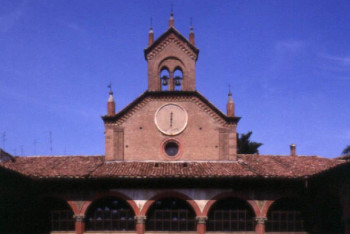The conflicts between the Guelphs and the Ghibellines continued throughout the 14th century, perpetuating the administrative and governmental turmoil which, in order to be settled or solved, often required key representatives of the University to enter the political arena.
As a result, the Studium was able to enjoy advantages and benefits, but at the same time it was also subject to stricter controls and supervision.
For instance, in 1309, a representative of the Podestà and a representative of the Captain of the People had to be present at the elections of the rectors, which until then had always been held independently of the local authorities.
After the papal seat had moved to Avignon (1309), Pope John XXII sent his nephew Bertrando del Poggetto to preside over the Italian territories. Once settled in Bologna, he ruled despotically. The citizens reacted by destroying his fortress near Porta Galliera (1334) and preferred to entrust power to one of their high representatives who respected the pre-existing political order: Taddeo Pepoli (1337).
The Pepoli family, registered with the Arte del Cambio (money changers’ guild), had made a fortune by loaning money to university students and, like many others, had worked their way to the top of the administrative ladder. Under their rule, Bologna enjoyed a brief period of peace, which was then abruptly interrupted when Taddeo’s sons, Giacomo and Giovanni – who were less experienced than their predecessors – sold the city, which had already been badly hit by the plague in 1348, to the powerful Visconti family (1350).
However, the rule of this Milanese family did not last long as it was weakened by family feuds and claims. After only 10 years, they handed over the Commune to Cardinal Egidio d’Albornoz (1360), who thus succeeded in uniting the city with the other territories of the Papal States.
The Church was preparing its resurgence in Italy and considered Bologna to be of critical importance in reinstating its power.
In those same years, Petrarch wrote to Pope Urban V, the last Avignon pope, reminiscing about the happy years he had spent studying law at the University of Bologna (1320-26), but also complained about the current situation of the Studium and the city.
In order to take an active role also in the Studium, the Holy See strategically founded the Faculty of Theology (1360), thus bringing about changes to a pedagogical offer which, until then, had remained secular and scientific.

However, the order reported by the cardinal legates was not enough to contain the new revolts in Bologna, and the city was able to regain its independence.
It was 1376, the time of the so-called Signoria del popolo e delle arti (Seigniory of the people and the arts).
This 20-year period was marked by great prosperity and by the construction of some of Bologna’s landmark buildings: the Palazzo della Mercanzia (1384), which was the heart of the Mercato di Mezzo, the economic driving force of the city; the Basilica of San Petronio (1390), an imposing church and spiritual rival of the nearby Cathedral, and the Palazzo dei Notai(1381), the seat of the city’s most powerful guild, closely linked to the Studium and to power.
As with the main political and commercial offices, the office of the papal representative was assigned to a teacher of the Studium: Giovanni da Legnano, a prominent jurist and professor of international renown, and the most learned supporter of Pope Urban VI’s views during the heated religious schism in the West (1378-1417).
By then, the students, for their part, had lost their autonomy and power, both within and outside the University.
In 1381, the Commune imposed a new magistracy on them, electing four Reformers of the Studium each year, who were in charge of drafting contracts with the teachers, drawing up study plans, choosing the subjects of courses, and even appointing the punctator, the person responsible for overseeing the proper functioning of the university, a position which until then had been reserved for students.
The students’ private Universities were thus being transformed into the Studium of Bologna.
